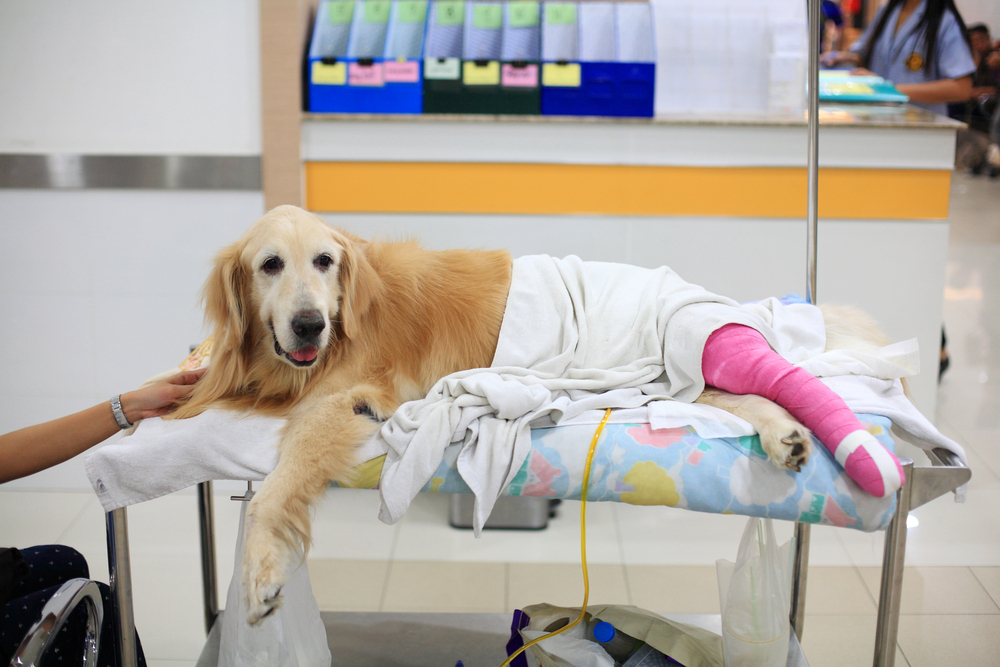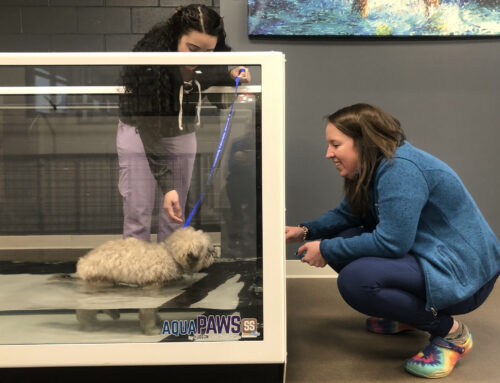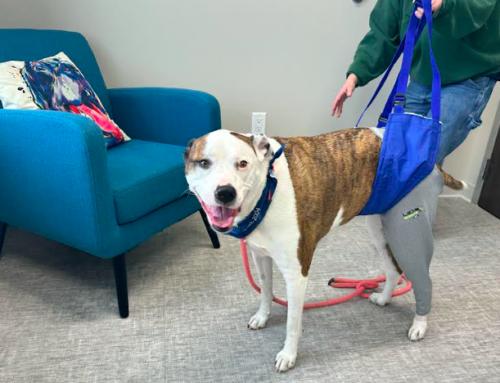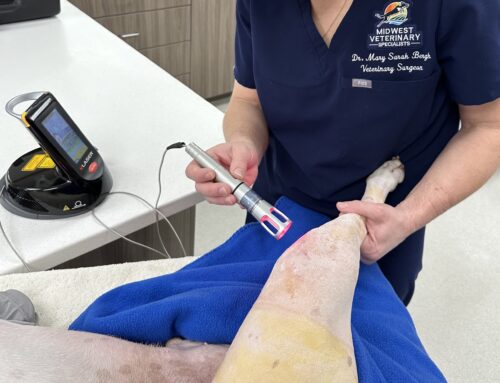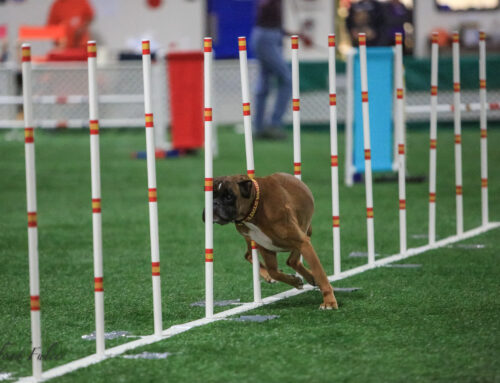Cranial cruciate ligament (CCL) disease (i.e., CCL rupture or tearing) is one of the most common causes of hindlimb lameness in dogs, and can result in significant pain and decreased mobility. At Midwest Veterinary Veterinary Specialists, we want your dog to live the most active, enjoyable life possible, especially if they are affected by a condition that limits their mobility. To help you better understand CCL disease in dogs, we answer some frequently asked questions.
Question: What causes cranial cruciate ligament disease in dogs?
Answer: The cranial cruciate ligament is an important stabilizer inside the dog’s stifle (i.e., knee) joint. In humans, this structure is called the anterior cruciate ligament (ACL). Whereas humans tear their ACLs primarily from trauma, dogs tear their CCLs from a progressive degenerative condition. In rare cases, dogs can develop acute CCL injury, caused by hyperextension or excessive strain on the ligament.
Unfortunately, the CCL is unable to heal and partial CCL tears will progress to full tears over time. Due to the underlying degenerative condition, osteoarthritis and bilateral disease is common—40% to 60% of dogs with CCL disease in one knee will eventually develop the problem in their other knee.
Q: What dogs are at risk for cranial cruciate ligament disease?
A: CCL disease can affect any dog, but certain risk factors predispose some dogs. These include:
- Breed — Certain breeds, such as rottweilers, Newfoundlands, Staffordshire terriers, mastiffs, Saint Bernards, Chesapeake Bay retrievers, and Labrador retrievers, are at increased risk. A genetic component of CCL disease has been identified in several breeds.
- Obesity — The increased strain placed on the dog’s joints, and the chronic inflammation caused by the excess fat cells, predispose overweight dogs to CCL disease.
- Conformation — Dogs who have an excessively straight hindlimb conformation are at higher risk.
- Age — Senior dogs are also at increased risk.
Q: What are cranial cruciate ligament disease signs in dogs?
A: The primary sign of CCL disease is limping on one or both back legs. In acute cases, the dog may vocalize and immediately stop bearing weight on the affected limb. Dogs affected by slower ligament degeneration may exhibit more subtle signs, such as lameness after heavy activity which improves with rest, difficulty rising after sitting, trouble jumping on surfaces, decreased overall activity, affected limb muscle loss, joint swelling, and overall stiffness.
Q: How is cranial cruciate ligament disease diagnosed in dogs?
A: At Midwest Veterinary Specialists, we use several diagnostic techniques to determine if your dog has CCL disease. These include:
- Gait evaluation — CCL disease is high on the suspect list when a dog presents with a hindlimb lameness. We observe your dog as they walk, trot, and as they transition from a sitting to standing position.
- Joint palpation — We palpate your dog’s joints, feeling for periarticular joint thickening, excessive joint fluid, and firm swelling over the dog’s tibia (i.e., the medial buttress sign) that is present in many CCL disease cases.
- Joint manipulation — We manipulate your dog’s joints using techniques such as the cranial drawer test and the tibial compression test to determine if a joint is not stable. Range of motion in the stifle is evaluated and potential meniscal injury is assessed. Careful palpation of the patella is also performed to determine if other conditions, such as patella luxation, are present.
- X-rays (i.e., radiographs) — We take radiographs to assess joint swelling, detect osteoarthritis, and rule out other potential diseases. In addition, our calibrated radiographs are very important for surgical planning and execution.
- Arthroscopy — Using small cameras in a minimally invasive surgery, the damaged CCL can be visualized directly. Most cases can be diagnosed without the need for surgery, however.
Q: How is cranial cruciate ligament disease treated in dogs?
A: Medical treatment, including pain medications, exercise modification, joint supplements, and physical rehabilitation, may be appropriate in some cases, but most dogs require surgical intervention to correct the joint instability and treat meniscal tears. Procedures include:
- Osteotomy-based techniques — In these procedures, the tibia bone is cut and repositioned to change the knee joint’s biomechanics to help stabilize the joint in a dynamic fashion. These procedures include:
- Tibial plateau leveling osteotomy (TPLO) — This surgical technique involves making a circular cut around the top of the tibia, rotating the contact surface to form a more level orientation, and using a bone plate and screws to hold the bone in the new position.
- Tibial tuberosity advancement — This surgical technique involves making a linear cut along the front of the tibia, advancing the section (i.e., the tibial tuberosity) forward, again using a bone plate and screws.
- Suture based techniques — In these techniques, the joint instability can be physically restricted and stabilized using certain suture techniques. These procedures include:
- Extracapsular suture stabilization — Suture material is used outside to stabilize the joint until scar tissue forms around the joint and provides stability.
- Tightrope technique — Holes are drilled in the femur and tibia, and suture material is placed inside to help stabilize the joint.
Appropriate post-operative care is crucial to ensure the surgical repair doesn’t fail. Your dog’s activity will be limited for about six to ten weeks, and specific physical rehabilitation exercises will be recommended to help your pet recover as quickly as possible.
Q: Can cranial cruciate ligament disease be prevented in dogs?

A: Not every CCL injury can be prevented, but you can take steps to decrease your dog’s risk, including:
- Keep your dog at a healthy weight — Feed your dog a healthy diet and measure their portions to ensure they receive the amount that correctly meets their energy requirements. Keeping them at a healthy weight will prevent added strain on their joints.
- Exercise your dog daily — Regular exercise will help strengthen your dog’s muscles, tendons, and ligaments, and help support their knee joint. Increasing core strength can be especially helpful. Formal conditioning and fitness programs at Midwest Veterinary Specialists can help maximize physical strength.
- Avoid inconsistent exercise — Don’t allow your dog to be a couch potato during the week and then try to make up for their lack of exercise on the weekend, which can lead to injury.
CCL rupture is common in dogs, but you can take steps to decrease your dog’s risk. If your dog has a hindlimb lameness, contact our team at Midwest Veterinary Specialists, so we can determine why they are limping, and get them back on all four feet as soon as possible.


